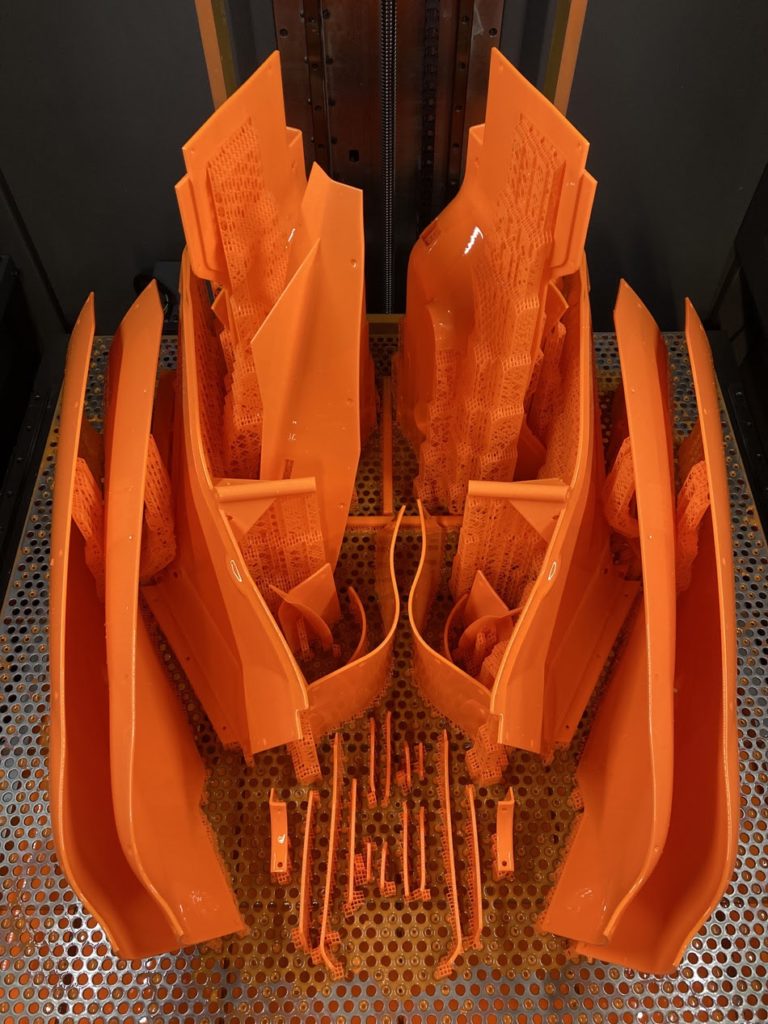Stratasys announced that the UK-based Formula One team McLaren Racing is 3D printing up to 9,000 parts a year with Stratasys’ Neo800 stereolithography (SLA) printers. McLaren currently has five Neo800 systems, which the auto team uses for both rapid prototyping, as well as tooling and parts production.
Members of the McLaren team noted the ability to save costs and produce parts much more rapidly than would have otherwise been possible, by incorporating in-house additive manufacturing (AM). One of the most crucial applications for McLaren in this regard is the use of AM for producing 60 percent scale models for wind tunnel testing, an indispensable part of the work of Formula One racing teams.

In a press release about McLaren’s use of Stratasys’ platform, Tim Chapman, the head of AM at McLaren, commented, “In addition to speed, we can now produce wind tunnel parts with supreme accuracy, detail and surface finish, which has enabled our team to enhance testing and find innovative new ideas to improve performance. I cannot overstate how important these benefits are in Formula One, with super tight deadlines to deliver cars to the next race, and where the smallest design iteration can make all the difference between winning, losing or making up positions on the grid.”

In addition to printing jigs and templates, the team was also able to replace small molds that were previously made from metals with printed polymer molds. This saves significant amounts of money, at a time when the FIA (the regulatory body in charge of Formula One) has brought the budget cap for racing teams down dramatically from what it was before COVID.
While the race car aspect is obviously exciting, observers of the AM sector might find it even more exciting that, in the press release, Stratasys touts McLaren’s use of Somos PerFORM Reflect resin, as it is a Covestro product. Last month, Stratasys made one of the most notable acquisitions of the year in the AM sector, when it purchased the AM business of Germany-based Covestro, which is one of the world’s largest chemical companies.
Obviously, this sheds some light on the motivating factors behind the acquisition, and potentially suggests a key part of Stratasys’ growth strategy moving forward. Any use-case example from Formula One could possibly translate into other areas of the automotive sector, especially hypercars. If that turns out to be the case, Stratasys will have secured substantial control over certain aspects of the automotive AM sector by purchasing Covestro’s AM business.
Images courtesy of Stratasys
Subscribe to Our Email Newsletter
Stay up-to-date on all the latest news from the 3D printing industry and receive information and offers from third party vendors.
You May Also Like
NSF Awards Kentucky $1M for Advanced Manufacturing
The National Science Foundation has awarded a $1 million grant to the University of Louisville for the Advancing Manufacturing and Building Construction Technologies (NSF AMT) project. This initiative is part...
3D Printing News Briefs, May 11, 2024: 3D Printed Stent, Tower, Sculptures, & More
We’re starting off with medical research in today’s 3D Printing News Briefs, as researchers in Korea used CT images and 3D printing to fabricate an educational simulator for a mastoidectomy....
3D Printing Unpeeled: Wind Turbines, Probiotics and Lenses
TPI Composites, ORNL and Ingersoll Rand are working to make wind turbine tooling segments that can be 18.3 meters long. These elements also include resistive wires that help keep the...
Tethon 3D Releases Cost-effective Bioprinter
Tethon 3D, known for its ceramic-loaded DLP materials, custom resins, and DLP 3D printers, has recently released a bioprinter. Vat polymerization printers like DLP systems have been widely used by...
































